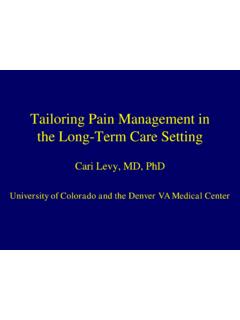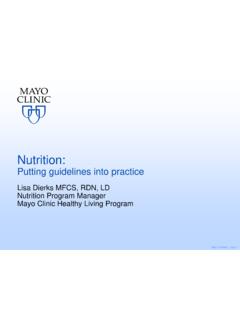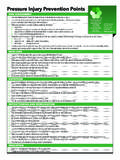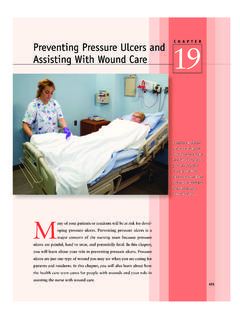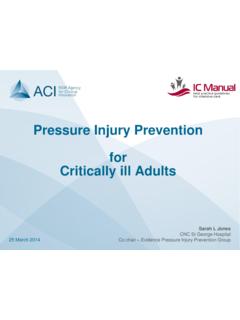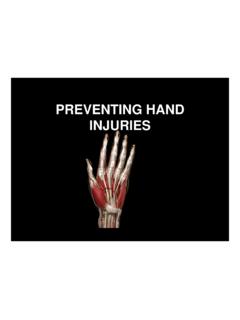Transcription of Gauging Pressure Ulcers - HealthInsight
1 Gauging Pressure Ulcers : A Nursing Home s Guide to prevention and Treatment Gauging Pressure Ulcers : Introduction Pressure Ulcers are a significant problem across all ages and health care settings. Multiple factors put residents at risk for developing a Pressure ulcer , including immobility, chronic illness, incontinence, poor nutrition, altered level of consciousness, altered sensory perception and a history of having Pressure Pressure Ulcers come at a high cost to everyone. They result in pain, suffering, diminished quality of life and even death for some residents. For a nursing home, they represent extra staff hours and medical supplies spent caring for a preventable condition, as well as more residents hospitalized. The cost of treating a single full-thickness Pressure ulcer can be as high as $70,000, with the total treatment cost for Pressure Ulcers in the US surpassing $11 billion per Although Pressure Ulcers are preventable, more than one in every 10 of Missouri nursing home residents developed a Pressure ulcer in 2007.
2 The Centers for Medicare & Medicaid Services has long focused on helping nursing homes prevent Pressure Ulcers , but in 2008 they extended this effort across care settings. Hospitals now have a payment incentive to partner with nursing homes on Pressure ulcer prevention a good thing since 20 percent of nursing home Pressure Ulcers originate outside the nursing home, generally in the acute hospital setting. No matter where you are in your prevention efforts, now is the time to take a look at your care processes with fresh eyes. First, review what the law says about Pressure Ulcers . See this toolkit s summary of the federal guidelines Understanding CMS Interpretation of Tag F314. Then, use the included Pressure ulcer Facility Assessment Checklists to take a critical look at your current practices.
3 Every one of these systems is crucial to Pressure ulcer prevention , so take your time completing this assessment. As you assess, call on other staff to help you answer questions completely and honestly. Once you ve completed the assessment and identified key areas for improvement, review the clinical reference tools, reminder tools and sample forms included in this toolkit. Feel free to adapt them to meet your individual needs. 1 Reddy M, Gill SS, Rochon PA. Preventing Pressure Ulcers : A systematic review. JAMA. 2006; 296: 974-984. 2 Reddy M, Gill SS, Rochon PA. Preventing Pressure Ulcers : A systematic review. JAMA. 2006;296:974-984. Pressure Ulcers : Table of Contents This table of contents provides an overview of the assessment and clinical reference tools for Pressure Ulcers contained in this document.
4 For further information, see the following pages for tool descriptions organized by section. If you re viewing this document on your computer, click on the tool name in the table of contents below, and you will be taken directly to the resource. To download and print tools individually, go to I. Guidelines and Example Policies a. Understanding CMS Interpretation of F314 b. MDS Skin Condition Coding Tip Sheet II. Facility Assessment and Protocols a. Facility Assessment Checklists b. Sample Protocol III. Resident Assessment and Monitoring Tools a. Braden Scale b. Skin Tear Risk Assessment c. LTC Dehydration Risk Assessment d. Comprehensive Admission Skin Assessment e. Licensed Nurse Weekly Skin Assessment f. CNA Shower Assessment g. Daily Skin Monitoring Tool h.
5 Systems Investigative Audit Tool IV. prevention Tools a. Pressure ulcer Prediction, prevention and Treatment Pathway b. Tissue Tolerance and Individualized Turning Schedule c. Managing Tissue Loads d. Support Surface Characteristics and Considerations V. Treatment Tools a. Treatment Product Categories b. Nutritional Wound Healing Guidelines c. Selected Characteristics for Support Surfaces VI. Communication Among Providers a. SBAR Skin Care Instructions VII. Education a. Resident and Family Education (PUP) Brochure b. Facility/staff education i. Staging Guidelines from National Pressure ulcer Advisory Panel ii. Pressure ulcer Classification Pocket Cards (see ) iii. CNA Knowledge and Attitude Survey Pressure Ulcers : Tool Descriptions I. Guidelines and Example Policies Understanding CMS Interpretation of F314: Summarizes the changes that CMS put into place with the revision of F-Tag 314.
6 Any time you make changes, quickly review this summary to ensure that you are meeting federal guidelines. MDS Skin Condition Coding Tip Sheet: Use this tip sheet to see, at a glance, how your coding questions might be addressed by the RAI manual. II. Facility Assessment and Protocols Facility Assessment Checklists: Complete this checklist as you review your approach to Pressure ulcer prevention and treatment. It will help determine your plan s comprehensiveness, its alignment with F-Tag 314 and good clinical practice. Sample Protocol: Use this protocol as a guideline for establishing a comprehensive Pressure ulcer prevention and Management Policy. Download the file as a separate Word document and modify it to suit your practices and materials. III.
7 Resident Assessment and Monitoring Tools Braden Scale: The Braden Scale is a research-based risk assessment used widely in the nursing community. The format allows for four separate assessments to aid in monitoring change over time. Skin Tear Risk Assessment: Evaluating for skin tear risk and interventions is different than evaluating for Pressure ulcer risk. The skin is our first line of defense, and we must protect the skin not only from Pressure Ulcers but from skin tears as well. This assessment helps determine if a resident is at risk for skin tears and offers potential interventions and a chart review audit, encouraging staff follow-through. LTC Dehydration Risk Assessment: Inadequate fluid intake can place residents at increased risk for Pressure Ulcers .
8 This tool will help determine resident dehydration risk, enabling staff to take a proactive approach. Comprehensive Admission Skin Assessment: Conducting a baseline comprehensive assessment of the skin is vital. Staff may use this form to guide them through the assessment. Licensed Nurse Weekly Skin Assessment: All residents should have their skin assessed weekly by a licensed nurse. This form encourages continuity in this documentation. CNA Shower Assessment: This form recognizes the important role CNAs play in Pressure ulcer prevention and empowers them to do regular skin checks. It provides a formal method of communication to the licensed nurses of their review of residents skin, which then would be followed up by the licensed staff. Daily Skin Monitoring Tool: This tool provides a formal approach for CNAs to report areas of concern with the resident s skin daily.
9 The licensed staff would then follow-up on noted areas of concern to provide a complete assessment. Systems Investigative Audit Tool: Use this tool as a guide during a chart review to ensure all appropriate steps are being taken for Pressure ulcer prevention and management. continued on next page > Pressure Ulcers : Tool Descriptions IV. prevention Tools Pressure ulcer Prediction, prevention and Treatment Pathway: This pathway assists staff in determining the appropriate care for the individual resident. It aids in staff critical thinking skills to ensure all areas of concern are met. Tissue Tolerance and Individualized Turning Schedule: This form can be used to document the assessment that led to the individualized turning schedule. Managing Tissue Loads: Use this tool to systematically choose the right mattress or wheel chair cushion, based upon a resident s level of need.
10 Support Surfaces: Characteristics and Considerations: Use this in-depth reference to learn more about the different support surfaces available for Pressure ulcer prevention or treatment. V. Treatment Tools Treatment Product Categories: Use this list outlining the major types of products to ensure your nursing center carries an appropriate range of materials for Pressure ulcer treatment. Nursing staff should choose the most effective dressing type based on wound stage, characteristics and potential concerns. Nutritional Wound Healing Guidelines: This sample procedure helps enhance Pressure ulcer healing by providing recommendations for nutritional intervention whenever possible. These are guidelines only. Individual patient and resident needs must be taken into consideration before implementation.
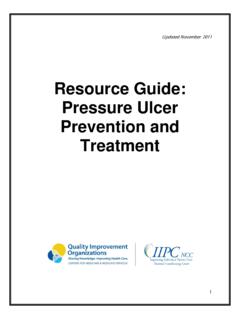
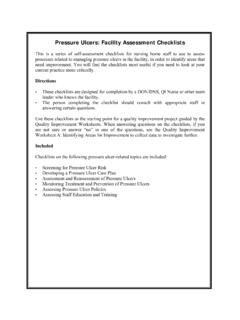
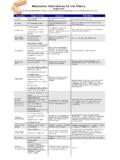
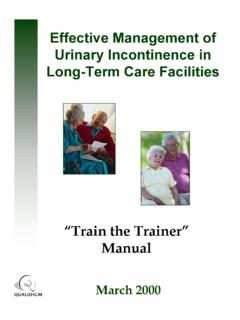
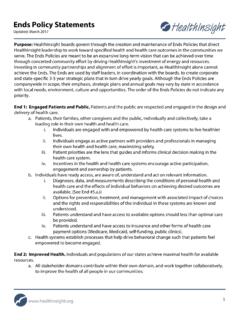
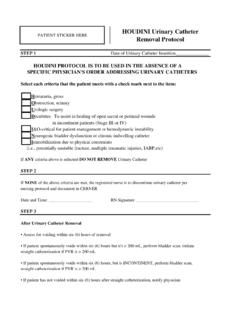
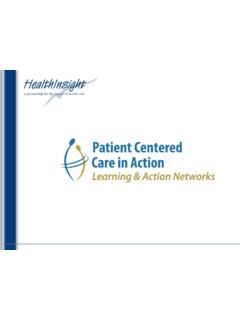
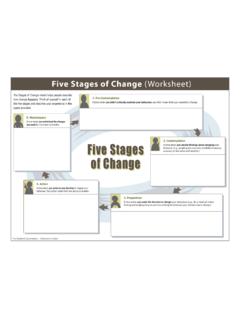
![2014 QAPI Plan for [Facility Name]](/cache/preview/6/6/9/d/c/1/a/b/thumb-669dc1ab5a6c622d3e508ca0e8604845.jpg)
